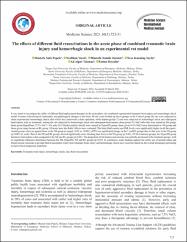| dc.contributor.author | Pepele, Mustafa Sefa | |
| dc.contributor.author | Yücel, Neslihan | |
| dc.contributor.author | Öztanır, Mustafa Namık | |
| dc.contributor.author | Karadağ, Neşe | |
| dc.contributor.author | Takmaz, Ali Alper | |
| dc.contributor.author | Özyalın, Farma | |
| dc.date.accessioned | 2022-03-15T12:17:10Z | |
| dc.date.available | 2022-03-15T12:17:10Z | |
| dc.date.issued | 2020-08-09 | en_US |
| dc.identifier.citation | Pepele, M. S., Yucel, N., Oztanir, M. N., Soylu, N. K., Takmaz, A. A., & Ozyalin, F. (2021). The effects of different fluid resuscitations in the acute phase of combined traumatic brain injury and hemorrhagic shock in an experimental rat model. Medicine, 10(3), 725-31. | en_US |
| dc.identifier.uri | https://pdfs.semanticscholar.org/260b/4bcbcba93d4a3931730865d9ce409130ff3d.pdf | |
| dc.identifier.uri | https://hdl.handle.net/20.500.12899/642 | |
| dc.description.abstract | It was aimed to investigate the utility of different fluid replacement therapies in the acute phase of a combined experimental traumatic brain injury and hemorrhagic shock model in terms of biochemical, hemostatic and pathological changes in the brain. 48 rats were divided up into 6 groups (n=8). Control group (S) rats were subjected to sham experimental hemorrhagic shock after which they underwent a sham operation, while trauma group (T) rats were subjected to hemorrhagic shock and subsequent head trauma with no treatment. Among the rats subjected to hemorrhagic shock and subsequent head trauma, those given 3% NaCl after this were named as HS group; those given HyperHeas [7.2% NaCl / 6% poly (O-2-Hydroxyethyl) starch] were named as HyperHS group; those given 0.9% NaCl were determined as NS group and those given ringer lactate as RL group. 24-hours later, the fluids’ effects were evaluated. The brain fluid content and INR levels were significantly higher in all the experimental groups when set against those in the NS group (p ranged <0.01 to <0.001). aPTT was significantly longer in the T and HS groups than in that seen in the NS group (p<0.001 for each). Rats in the HS and RL groups showed significantly more bleeding than those in the NS group (p<0.05). Of the treatment groups, the HyperHS group had more brain edema when compared to the NS and RL groups (p<0.05). The proportion of red neuron and necrosis was partially decreased in the treatment groups, with no significant difference determined between the HS, HyperHS, NS and RL groups (p>0.05). In conclusion, study findings support the safely use of normal saline and Ringer lactate solutions in prompt fluid resuscitation where both traumatic brain injury and hemorrhagic shock have occurred, based on the overall advantages pertaining to each critical prognostic parameter. | en_US |
| dc.language.iso | en | en_US |
| dc.relation.ispartof | Medicine Science | en_US |
| dc.rights | info:eu-repo/semantics/openAccess | en_US |
| dc.subject | Traumatic Brain İnjury | en_US |
| dc.subject | Hemorrhagic Shock | en_US |
| dc.subject | Rats | en_US |
| dc.subject | Fluid Resuscitation | en_US |
| dc.title | The Effects Of Different Fluid Resuscitations İn The Acute Phase Of Combined Traumatic Brain İnjury And Hemorrhagic Shock İn An Experimental Rat Model | en_US |
| dc.type | Article | en_US |
| dc.authorid | 0000-0002-5505-6250 | en_US |
| dc.authorid | 0000-0001-6486-6389 | en_US |
| dc.department | MTÖ Üniversitesi, Tıp Fakültesi, Dahili Tıp Bilimleri Bölümü | en_US |
| dc.institutionauthor | Pepele, Mustafa Sefa | |
| dc.institutionauthor | Özyalın, Fatma | |
| dc.identifier.doi | 10.5455/medscience.2020.12.261 | |
| dc.identifier.volume | 10 | en_US |
| dc.identifier.issue | 3 | en_US |
| dc.identifier.startpage | 725 | en_US |
| dc.identifier.endpage | 731 | en_US |
| dc.relation.publicationcategory | Makale - Uluslararası - Editör Denetimli Dergi | en_US |
| dc.indekslendigikaynak | TR-Dizin | en_US |


















